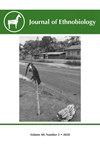瑞典历史上对蝙蝠的态度
IF 1.3
3区 社会学
Q1 ANTHROPOLOGY
引用次数: 10
摘要
摘要蝙蝠不寻常的外表一直让人们着迷,但对它们的恐惧也很常见,尤其是在西方社会。在最近的COVID-19大流行期间,蝙蝠经常被指控携带和传播危险病毒的比例过高,这成为了世界各地的头条新闻。我们通过搜索提到蝙蝠的古老文献和原始博物馆记录,调查了这种思想在瑞典的起源和持久性。在圣经中,蝙蝠是一种不洁的动物。至少从中世纪开始,它就被用作魔鬼的象征,深色皮肤的翅膀与天使的白色翅膀形成鲜明对比。然而,根据我们的民间传说记录,人们通常以不同的、普遍积极的方式看待蝙蝠,并受到尊重。它的神奇属性,特别是包含在血液、眼睛和翅膀中,可以在各种日常环境中带来好运和防止厄运。少数记录提到蝙蝠被用于巫术、黑魔法,或者遵循宗教教条,声称它们是丑陋或不洁的,不可能是上帝的作品。我们没有发现任何迹象表明蝙蝠被认为具有攻击性、危险性或携带疾病。因此,我们推测在瑞典(北欧)历史上很少有人害怕蝙蝠,尽管有宗教信息。因此,过去人们对蝙蝠的普遍态度似乎与目前西方社会的看法相反。本文章由计算机程序翻译,如有差异,请以英文原文为准。
Attitudes towards Bats in Swedish History
Abstract. Bats have always fascinated people by their unusual appearance, but fear towards them is also common, particularly in Western societies. Making headlines worldwide during the recent COVID-19 pandemic, bats were all too often accused of carrying and transmitting a disproportionate share of dangerous viruses. We enquired about the origin and persistence of this thinking in Sweden by searching old literature and original museum records where bats are mentioned. In the Bible, the bat is an explicitly unclean animal. At least since the Middle Ages, it has been used as a symbol of the Devil, with the dark skin wings in deliberate contrast to the white wings of angels. However, according to our folklore records, the bat was usually seen in a different and generally positive context by the people, and was treated with respect. Its magic properties, particularly contained in the blood, eyes, and wings, could bring fortune and prevent bad luck in various everyday contexts. A minority of records refer to bats being used in witchcraft, black magic, or, following the religious dogma, claiming that they are ugly or unclean and cannot be the work of God. We found no indication that bats were considered aggressive, dangerous, or to carry disease. Hence, we surmise there was little fear of bats in Swedish (Nordic) history, despite the religious message. Hence, the general attitude towards bats in the past seems to have been opposite to the view currently met in Western societies.
求助全文
通过发布文献求助,成功后即可免费获取论文全文。
去求助
来源期刊

Journal of Ethnobiology
Social Sciences-Anthropology
CiteScore
4.80
自引率
3.40%
发文量
21
审稿时长
>12 weeks
期刊介绍:
JoE’s readership is as wide and diverse as ethnobiology itself, with readers spanning from both the natural and social sciences. Not surprisingly, a glance at the papers published in the Journal reveals the depth and breadth of topics, extending from studies in archaeology and the origins of agriculture, to folk classification systems, to food composition, plants, birds, mammals, fungi and everything in between.
Research areas published in JoE include but are not limited to neo- and paleo-ethnobiology, zooarchaeology, ethnobotany, ethnozoology, ethnopharmacology, ethnoecology, linguistic ethnobiology, human paleoecology, and many other related fields of study within anthropology and biology, such as taxonomy, conservation biology, ethnography, political ecology, and cognitive and cultural anthropology.
JoE does not limit itself to a single perspective, approach or discipline, but seeks to represent the full spectrum and wide diversity of the field of ethnobiology, including cognitive, symbolic, linguistic, ecological, and economic aspects of human interactions with our living world. Articles that significantly advance ethnobiological theory and/or methodology are particularly welcome, as well as studies bridging across disciplines and knowledge systems. JoE does not publish uncontextualized data such as species lists; appropriate submissions must elaborate on the ethnobiological context of findings.
 求助内容:
求助内容: 应助结果提醒方式:
应助结果提醒方式:


